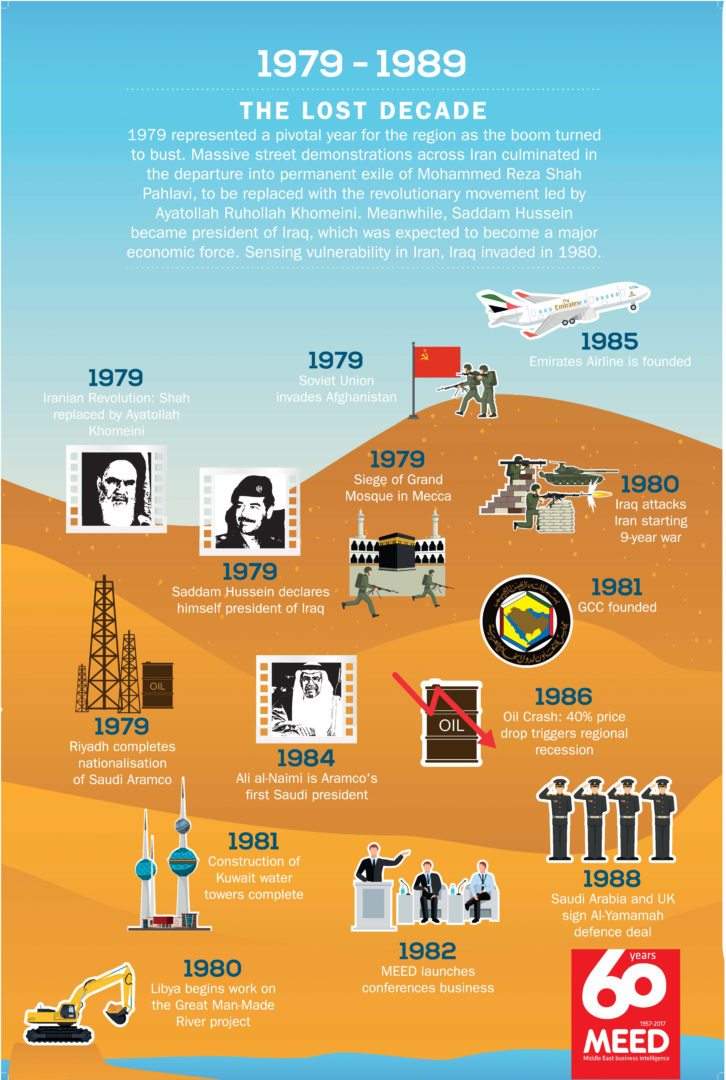

1979 represented a turning point for the region as boom turned to bust

MEED 1979-1989 infographic
MEED 1979-1989 infographic
Flush with oil revenues, the Middle East seemed set for a period of unparalleled economic development as the 1980s dawned. But the conflict and setbacks that were to be the dominant feature of the decade were immediately evident.
In the final week of 1979, the Soviet Union invaded Afghanistan, ostensibly at the request of the government.
The malaise spread as the revolutionary government in Iran struggled to consolidate its authority and project its message to the rest of the Middle East. In the early months of 1980, violent clashes started on the border with Iraq.
Internationally reviled and isolated following the seizure of the US embassy and its staff in November 1979, Iran looked vulnerable. On 22 September, Iraqs President Saddam Hussein ordered an all-out invasion of the Iranian oil province of Khuzestan in what he believed would be a short campaign aimed at confirming Iraq as the dominant Gulf power. It quickly became clear the war would be a long and damaging affair.
Drawn more closely together by the challenge of Iran, the six conservative states of Arabia formed in 1981 the GCC, a development that suggested they planned a coherent policy to coordinate defence strategies and economic programmes.
Because Iraqi exports were obstructed, oil prices reached record levels in the winter of 1980 despite Saudi Arabia pushing its own production to capacity. This provided a huge new rise in export earnings for the Middle East. Yet there was no disguising the debilitating impact the Iran-Iraq war was having on confidence as the stability of the region was consistently called into question by Irans determination to bring down Saddam Hussein and his Baathists.
The Middle East suffered a further blow in June 1982, when Israels Prime Minister Menachem Begin ordered the invasion of south Lebanon. Beirut was occupied, the Palestine Liberation Organization (PLO) was expelled and Lebanon disintegrated.
Nevertheless, economic development across the region reached a crescendo as oil exporters poured money into a mass of new infrastructure, industrial and agricultural schemes. New industries founded in the 1970s entered production. Defence spending also started to quicken.
But the consequences of the 1978-80 oil price rises soon started to emerge. By the middle of the decade, it was evident Opecs aggressive price policy was resulting in a massive loss of market share. As oil production was cut to support prices, leading oil exporters started to experience significant financial deficits.
In the summer of 1985, MEED forecast that Saudi Arabia, by then producing less oil than the UK, would have a current account deficit of more than $20,000 million that year. The prospect finally precipitated Opecs decision later in 1985 to abandon its price defence strategy and go for market share. In the summer of 1986, oil prices had fallen to less than $10 a barrel.
Political events compounded the regions economic problems. South Yemen erupted into factional conflict in early 1986. In February the same year, Iran captured the Fao Peninsula and looked like it was set to win the war. American bombers attacked Tripoli in 1986. The Kuwait assembly was suspended in the summer. And throughout the period, militias battled bloodily for control of Lebanon.
At last, exhaustion set in. In 1988, the Soviets announced they would withdraw from Afghanistan, Iran accepted a UN-sponsored ceasefire, the PLO declared it was ready to come to terms with Israel, and peace in Lebanon was heralded by the 1989 Taif agreement.
But this was a false dawn. By late 1989, it was evident Iraq was seeking drastic solutions to its pressing economic problems.
You might also like...

Rainmaking in the world economy
19 April 2024

Oman receives Madha industrial city tender prices
19 April 2024

Neom seeks to raise funds in $1.3bn sukuk sale
19 April 2024

Saudi firm advances Neutral Zone real estate plans
19 April 2024
A MEED Subscription...
Subscribe or upgrade your current MEED.com package to support your strategic planning with the MENA region’s best source of business information. Proceed to our online shop below to find out more about the features in each package.








